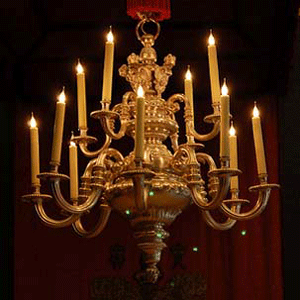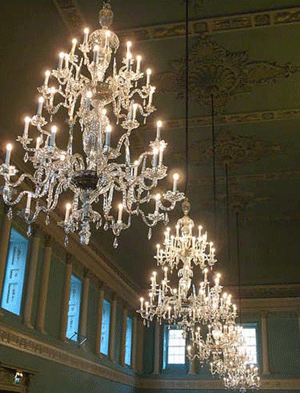Georgian lighting: the romance of candles
Many examples of wonderful Georgian lighting survive today, to remind us of the innovative, and grand Georgian, period

Confession: when it comes to the history of lighting, it isn't until the Georgian era that I start to get excited. There..., I've said it. The earlier rush lights and tallow candles were essential; extravagant Georgian lighting (albeit restricted to the wealthy elite) was romantic. The golden age of wax candles had arrived!
Now, a wax candle may not sound very exciting, but in a wealthy Georgian household, it was a status symbol. A great deal of care and money was spent on spectacular light fittings that mirrored the style of furniture and decor, housed the all-important candles and demonstrated the owner's wealth to guests.
Throughout the eighteenth century the way of life became progressively less formal. Socialising moved from a day time activity to evening balls and parties, making additional lighting essential. An extravagant Georgian evening out was likely to include a candle count running into hundreds.
Initially, crystal chandeliers were mostly metal frames adorned with crystal, but by 1720 glass techniques had developed such that the first truly glass chandeliers were crafted. Initially the arms were short with the candle holder, drip pan and arm welded into a single unit. A combination of social change and improving glass techniques led to a dramatic rise in the use of extravagant crystal chandeliers.

The poor light given off by wax candles was enhanced by the use of reflective surfaces around the room, such as gilt and mirrors. However, glass remained incredibly expensive and the glass tax introduced in 1745 ensured that large windows and crystal chandeliers were only found in the grandest homes. The crystal chandelier was the most luxurious of all light fittings and owning one was an exuberant, unmistakable display of your wealth.
* Subscribe to Country Life; Country Life Digital Edition

In 1771 the New Assembly Rooms opened in Bath. Following an earlier disaster in the Ball room, when a chandelier arm ‘fell down during the time the company was dancing', William Parker won the contract for a set of three forty-light chandeliers for the tea room. Introducing neo-classical elements into the design of a glass chandelier for the first time, Parker continued to push the boundaries of chandelier design when he replaced the controversial Ball room chandeliers a few months later. Today, these most famous chandeliers are valued at around £2.5million. They originally cost £999, with the bill for candles and oil being £556 for the first season alone!
Sign up for the Country Life Newsletter
Exquisite houses, the beauty of Nature, and how to get the most from your life, straight to your inbox.
William Parker's Bath chandeliers put him, and them, firmly in the limelight and at the forefront of Georgian fashion. Towards the end of the 18th Century his chandeliers could be found in grand houses from Chatsworth to China and, fortunately for us, many stunning examples of his innovative designs survive and delight us today.
This article was written by Karen Wallis-Smith, who owns Fritz Fryer Antique Lighting. Fritz Fryer offers an extensive lighting sales, design and consultancy service, specialising in the high quality restoration of period fittings. They also work with private and commercial clients to create sympathetic lighting solutions for period properties and their on-site workshop repair all fittings, by hand, to the highest possible standard.
Karen Wallis-Smith, owns Fritz Fryer Antique Lighting who offer an extensive lighting sales, design and consultancy service, specialising in the high quality restoration of period fittings. They also work with private and commercial clients to create sympathetic lighting solutions for period properties and their on-site workshop repair all fittings, by hand, to the highest possible standard.

This is an article from ProjectBook which provides a wide range of information for the conservation, restoration, care and repair of period and listed buildings. Fritz Fryer Antique Lighting is a member of the Heritage Register which contains over 500 vetted craftsmen, contractors and consultants from all over the UK. Updated daily with new content, the website features the heritage register, a products directory, informative articles, current news, events and more. For more information, visit www.projectbook.co.uk.
Country Life is unlike any other magazine: the only glossy weekly on the newsstand and the only magazine that has been guest-edited by HRH The King not once, but twice. It is a celebration of modern rural life and all its diverse joys and pleasures — that was first published in Queen Victoria's Diamond Jubilee year. Our eclectic mixture of witty and informative content — from the most up-to-date property news and commentary and a coveted glimpse inside some of the UK's best houses and gardens, to gardening, the arts and interior design, written by experts in their field — still cannot be found in print or online, anywhere else.
-
 Two quick and easy seasonal asparagus recipes to try this Easter Weekend
Two quick and easy seasonal asparagus recipes to try this Easter WeekendAsparagus has royal roots — it was once a favourite of Madame de Pompadour.
By Melanie Johnson Published
-
 Sip tea and laugh at your neighbours in this seaside Norfolk home with a watchtower
Sip tea and laugh at your neighbours in this seaside Norfolk home with a watchtowerOn Cliff Hill in Gorleston, one home is taller than all the others. It could be yours.
By James Fisher Published
